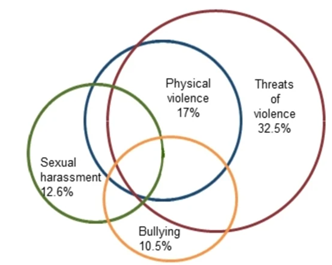Workplace violence remains a significant concern for businesses worldwide, manifesting in various forms ranging from verbal threats and harassment to physical aggression and active shooter incidents. According to the American Medical Compliance (AMC), nearly 2 million workers in the U.S. experience some form of workplace violence each year. To tackle this critical issue, many corporations are adopting virtual reality (VR) training as a proactive approach to equip employees with the skills needed to prevent and effectively respond to violent situations.
The Role of VR Training in Addressing Workplace Violence
VR technology provides a unique and engaging modality for training, allowing employees to interact with lifelike simulations of potentially violent scenarios. Unlike traditional training methods, such as live lectures or online videos and presentations, VR immerses learners in 3D environments that closely replicate real-world situations.
Key benefits of VR training for workplace violence prevention include:
- Realistic Scenario Practice: VR allows employees to rehearse de-escalation techniques in situations that mimic everyday workplace challenges. For example, an employee can learn to manage an angry customer or defuse a conflict between colleagues in a safe, controlled environment.
- Improved Retention and Confidence: Studies have shown that immersive learning experiences result in higher knowledge retention rates compared to traditional training methods. Employees leave training sessions feeling more confident in their ability to handle stressful situations.
- Consistent and Scalable Training: VR modules ensure all employees receive uniform training experiences, regardless of employee location. This consistency is particularly valuable for large organizations with a distributed workforce.
- A Risk-Free Environment: Employees can experiment with different responses and learn from mistakes without real-world consequences, facilitating a deeper understanding of how to handle conflicts and emergencies.
Furthermore, the benefits of using VR for training mitigate multi-hazard exposure. As demonstrated in the overlapping of the circles of the Venn diagram below, it has been shown that these hazards have the possibility of co-occurring within a period of 12 months.

Using VR for Active Shooter Response Training
Active shooter incidents represent one of the most severe and complex forms of workplace violence. Preparing employees to respond effectively to such high-stakes scenarios is critical, and VR offers a comprehensive and impactful solution.
VR active shooter training offers several key advantages. One, it enhances situational awareness by immersing employees in realistic, chaotic scenarios, enabling them to identify threats, exits and safe areas under simulated stress. The training also improves decision-making under pressure by presenting high-stakes situations requiring rapid judgment, such as how to confront an aggressor.
Additionally, VR training fosters collaboration and communication through team-based scenarios, encouraging coordinated responses. It builds emotional preparedness and resilience by exposing employees to simulated emergencies, reducing the likelihood of panic or paralysis in real-life events. Immersive learning provides a safe environment to practice critical skills and improve overall preparedness for active shooter events.
Deployment Strategies for Corporations
To maximize the effectiveness of VR-based active shooter training, businesses should follow these steps:
- Risk Assessment and Goal Setting: Begin by analyzing the organization’s specific vulnerabilities and defining clear objectives for the training program. For example, identify whether the primary focus should be on de-escalation, evacuation or team coordination.
- Selecting the Right VR Platform: Partner with VR training providers that specialize in workplace safety. Evaluate their offerings for realism, ease of use, scalability and integration with existing training systems.
- Employee Engagement: Educate employees about the benefits of VR training and address concerns related to privacy or technology adoption. Transparent communication fosters trust and enthusiasm.
- Integration With Broader Safety Initiatives: VR training should complement other safety measures, such as physical security upgrades, incident reporting protocols and traditional prevention drills.
- Ongoing Evaluation and Updates: Regularly review training outcomes using analytics provided by VR platforms. Use this data to identify gaps, refine scenarios and ensure the program evolves with emerging threats.
Case Studies: Success Stories in VR Training
VR active shooter training offers significant advantages in preparing employees for high-stress emergency situations. It enhances situational awareness by immersing trainees in realistic emergency scenarios, allowing them to identify potential threats, locate exits and assess safe areas under simulated pressure. This immersive experience also strengthens decision-making skills by presenting high-stakes situations where rapid judgment is crucial, such as deciding whether to evacuate, hide or confront a threat.
Several corporations have successfully implemented VR training programs to mitigate workplace violence and improve active shooter preparedness. Walmart, for instance, utilizes VR to train employees for active shooter scenarios, immersing them in realistic simulations to improve their ability to make quick decisions and prioritize safety. Similarly, Verizon employs VR training modules to prepare store employees for various challenging situations, including robberies and violent customers. These efforts have contributed to a culture of preparedness, highlighting the effectiveness of VR training in improving overall workplace safety.
Challenges and Considerations
While VR active shooter training offers significant advantages, organizations must also consider potential challenges. Cost can be a barrier, as high-quality VR hardware and software can be expensive. However, technological advancements are driving costs down, making VR increasingly accessible.
Technical support is another consideration. Companies need resources to maintain VR equipment effectively, ensuring smooth operation and minimizing downtime.
Lastly, employee adoption is crucial. Resistance to new technology can hinder implementation. Clear instructions, demonstrations, and emphasis on training benefits, particularly the program’s role in enhancing personal safety, can help overcome resistance and encourage participation. Addressing these challenges proactively is key to successful VR training implementation.
Conclusion
VR is revolutionizing workplace violence prevention and active shooter response training. By providing immersive, hands-on experiences, VR empowers employees to develop critical skills in a safe, controlled environment.
For organizations, the investment in VR training translates to safer workplaces, more confident employees, and a proactive approach to addressing the growing concern of workplace violence. As the technology continues to evolve, VR will become an indispensable tool in workplace safety initiatives. VR active shooter training offers significant advantages in preparing employees for high-stress emergency situations.
Quelle:
